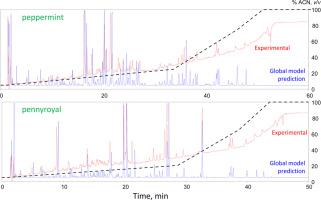Global retention models in reversed-phase liquid chromatography. A tutorial
IF 3.2
引用次数: 0
Abstract
Developing methods in liquid chromatography for complex samples with hundreds of constituents presents significant challenges, particularly when standards are unavailable or unknown, as is the case of natural products such as medicinal plants. Even when all standards are accessible, optimising experimental conditions for effective separation would require extensive, time-consuming experimentation, often impractical in real-world scenarios. To overcome these challenges, we recently introduced and validated a novel approach based on global retention modelling. This approach has been successfully applied not only to complex samples, but also to simpler ones where standards are available. Global retention models differentiate between solute-specific retention parameters and those characterising the column and solvent, which are shared across the entire set of analytes. These common parameters are derived from chromatographic data for a subset of compounds tracked across experiments in the training design. Once the initial model is built, it can be extended to include additional analytes outside the training set, significantly reducing the need for further extensive experiments. This tutorial provides a comprehensive background on global models, along with a step-by-step explanation of the novel approach. To illustrate its practical application, an example is presented involving a large set of diverse compounds, using a MATLAB set of functions created for this tutorial to showcase the implementation of global retention modelling.

反相液相色谱中的全局保留模型。教程
为含有数百种成分的复杂样品开发液相色谱方法是一项重大挑战,尤其是在没有标准品或标准品未知的情况下,如药用植物等天然产品。即使可以获得所有标准品,优化实验条件以实现有效分离也需要大量耗时的实验,这在现实世界中往往是不切实际的。为了克服这些挑战,我们最近引入并验证了一种基于全局保留模型的新方法。这种方法不仅成功地应用于复杂的样品,也应用于有标准样品的简单样品。全局保留模型区分了特定于溶质的保留参数和描述色谱柱与溶剂特征的参数,这些参数在整组分析物中是共享的。这些共用参数来自于在训练设计中对实验进行跟踪的化合物子集的色谱数据。一旦建立了初始模型,就可以对其进行扩展,以包括训练集之外的其他分析物,从而大大减少了进一步进行大量实验的需要。本教程全面介绍了全局模型的背景,并逐步解释了这种新方法。为了说明该方法的实际应用,本教程还提供了一个涉及大量不同化合物的示例,使用为本教程创建的一套 MATLAB 函数来展示全局保留模型的实现。
本文章由计算机程序翻译,如有差异,请以英文原文为准。
求助全文
约1分钟内获得全文
求助全文
来源期刊

Journal of chromatography open
Analytical Chemistry
CiteScore
2.50
自引率
0.00%
发文量
0
审稿时长
50 days
 求助内容:
求助内容: 应助结果提醒方式:
应助结果提醒方式:


